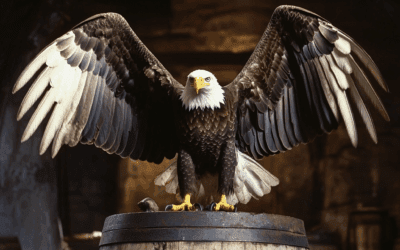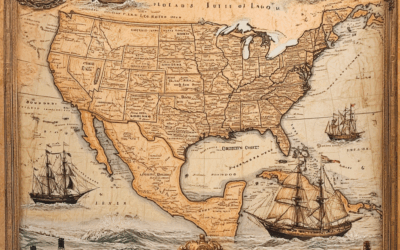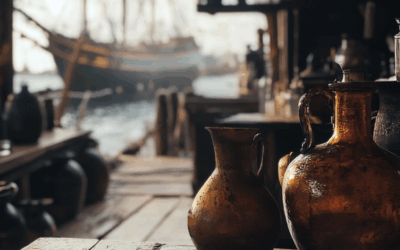Preserve the Legacy:
American Brandy & Rum

AMBRU Campaign
The Historic Legacy of American Brandy & Rum on the Global Stage
The AMBRU Campaign champions American Brandy and American Rum, working to position these spirits as iconic signatures of the United States on the global stage. Founded in 2020 by Caroline Porsiel and Christopher Brooks, the campaign emerged from a shared passion for uncovering the historical significance of American distilling and advocating for its economic potential. Our mission is to protect and elevate these made-in-USA liquors in international markets, ensuring their legacy as quality products with deep roots in America’s path to independence.
AMBRU Campaign Brief
Get our AMBRu Campaign Brief – a one-page summary with key facts, goals, and why reviving American Brandy and Rum matters.
AMBRU Campaign
“American Brandy and Rum beat British taxes in 1776—now they’ll beat foreign rivals in 2025.“

Caroline Porsiel
Founding Member
Caroline Porsiel oversees the crafting of fine spirits and liqueurs at House of Applejay Distillery in East Ellijay, Georgia. With over a decade of experience, she steers the development of premium spirits inspired by all-natural ingredients. Her deep appreciation for the history of distilling and traditional practices shapes her innovative approach, earning her recognition and awards in the craft distilling industry.

Christopher Brooks
Founding Member
Christopher Brooks is a historian and professor at East Stroudsburg University, specializing in legal and constitutional history. Since his studies at the universities of Edinburgh and Kassel, he has acquired over two decades of experience researching US and transatlantic history. His passion for historical legal traditions informs his teaching and writing, earning him recognition in the Federalist Society and beyond.
AMBRU Campaign
Reviving American Spirits, Rebuilding American Jobs
American Brandy and American Rum aren’t just spirits—they’re cornerstones of U.S. history and engines of untapped economic potential. Distilled since the 17th century, they powered colonial trade and fueled the spirit of independence. The AMBRU Campaign isn’t chasing Geographical Indications like Cognac or Scotch—we’re fighting for a distinct U.S. designation status to cement their place as premium American spirits, aged in North American oak, with a heritage predating bourbon. This isn’t just history; it’s a blueprint for a thriving industry and thousands of jobs. The numbers tell a compelling story.
A Multi-Billion-Dollar Market Ready to Soar
The global brandy market reached $22.12 billion in 2023 and is projected to hit $36.5 billion by 2030, growing at 6.8% annually [1]. The global rum market is on track to reach $21 billion by 2029 [2]. Bourbon, with its U.S. designation, generates $4.5 billion domestically [3]. American Brandy and Rum are ready to join this league. A designation status highlighting their quality and heritage could drive $1–2 billion in domestic market revenue by 2035. With strategic branding, these spirits can carve out a growing share of global markets, delivering a distinctly American experience to consumers worldwide.

Jobs, Jobs, Jobs—2,000 to 5,000 Strong
The spirits industry supports 1.6 million jobs nationwide, with bourbon alone powering 22,000 direct roles [3]. A designation status for American Brandy and Rum could spark 2,000–5,000 new jobs over the next decade, creating opportunities for distillers, farmers growing sugar cane and fruit, tourism workers, and logistics crews. Each new or expanded distillery injects $5.5 million into local economies [4]. With 20–30 new operations, that’s $110–$165 million annually, revitalizing communities from California’s vineyards to Southern cane fields.
Exports: Showcasing American Craftsmanship Globally
U.S. spirits exports hit $2.1 billion in 2023, with bourbon leading at $1.2 billion and brandy at $249 million [3]. American Rum, though trailing Caribbean competitors, has untapped potential. A designation status could propel brandy and rum exports to $500–$750 million by 2035, capturing global demand and challenging the $1.5 billion rum import market. This isn’t just revenue—it’s American craftsmanship shining on the world stage.
Tourism: Trails That Turn Heritage into Prosperty
The Kentucky Bourbon Trail drew 2.5 million visitors in 2023, contributing $300 million to the state [5]. An “American Brandy Trail” and “American Rum Trail,” tied to a national designation, could attract 500,000–1 million visitors annually, generating $50–$100 million and creating vibrant tourism hubs. From Northeast distilleries to Southern farms, these trails will invite enthusiasts to taste America’s spirit heritage, boosting local economies.
“American Brandy & Rum—older than bourbon, rich in heritage – deserve a designation status to spark a $1–2 billion industry. Let’s elevate American spirits and create 2,000–5,000 jobs!”
The AMBRU Vision
American Brandy and Rum—older than bourbon, rooted in colonial defiance—are overdue for their own designation status. Bourbon earned its place in 1964; now it’s time for these spirits to shine. This status will ensure quality, spark jobs, and build a legacy as bold as the nation itself. Join us to make American spirits a global force—2,000+ jobs and a thriving industry start here. Raise a glass to what’s possible and support the AMBRU Campaign with a free signup at x.ai/ambru.
[^1]: Grand View Research, “Brandy Market Size, Share & Trends Analysis Report,” https://www.grandviewresearch.com/industry-analysis/brandy-market
[^2]: Statista, “Rum – Worldwide,” https://www.statista.com/outlook/cmo/alcoholic-drinks/spirits/rum/worldwide
[^3]: Distilled Spirits Council, “2023 Economic Impact Report,” https://www.distilledspirits.org/news/2023-economic-impact-report/
[^4]: American Distilling Institute, “Economic Impact,” https://www.americandistillinginstitute.org/economic-impact/
[^5]: Kentucky Bourbon Trail, “Economic Impact,” https://kybourbontrail.com/economic-impact/
Timeline And Next Steps
The AMBRU Campaign seeks federal designations for American Brandy and Rum, including Straight categories, to boost a $5–6B industry, create 5,000–10,000 jobs, and drive $1B in exports by 2035. Below, explore the timeline, challenges, market impact, and implementation...
Current Market Baseline for American Brandy and Rum
To establish a starting point for achieving the AMBRU Campaign’s $1 billion revenue goal by 2035 for American Brandy and Rum, we assess 2025 annual revenue, production volume, and number of U.S. distilleries, using data from ambru.org’s homepage. AMBRU highlights a...
American Single Malt: A Blueprint for Protecting American Brandy and Rum
In a landmark decision, the Alcohol and Tobacco Tax and Trade Bureau (TTB) officially recognized American Single Malt as a distinct whiskey category on December 18, 2024, with the ruling taking effect on January 19, 2025. This milestone, achieved after nearly a decade...
AMBRU’s Plan to Win Designation for American Brandy and Rum
A Legacy Without Protection American Brandy and Rum trace their roots to the 1600s—before bourbon. By 1735, Georgia colonists were distilling their own, defying British rum bans 40 years before independence. Yet there’s no legislative protection for them as official...
Beyond the East Coast: Brandy’s Broader American Story
While the East Coast pioneered American brandy, the spirit’s journey stretched beyond, from Georgia’s experimental twists to the West Coast’s late bloom. This piece explores these lesser-known chapters, highlighting innovation and regional flair. Georgia’s Unique...
The Dawn of Commercial Distilling in North America
Imagine the raw shores of colonial North America in the early 17th century—ships heavy with molasses, the musk of fermenting mash rising from wooden vats, and still fires glowing in the dusk. The tale of commercial distilling here blends ingenuity, chemistry, and...
American Brandy: A Legacy of East Coast Spirit and Revolution
Signature brandies, distilled from grapes and apples, weave a rich thread through America’s history. From the East Coast’s earliest orchards and vineyards to frontier stills, these spirits shaped colonial life, fueled trade, and quietly defied imperial rule. This...
The Birthright of American Rum
Rum is more than a spirit; it’s a distilled chronicle of trade, resilience, and rebellion woven into the fabric of American history. This blog post traces rum’s evolution from ancient sugarcane fields to its pivotal role in shaping the United States, exploring its...
Geographical Indicators and Designated Products
In the artisanal spirits landscape, where authenticity reigns supreme, tools like geographical indicators (GIs) and designated product statuses can define a brand’s success. The AMBRU Campaign—short for American Brandy and Rum Campaign—is pushing for American Brandy...
Safeguarding America’s Distilling Legacy
The American Brandy & Rum Campaign (AMBRU) proudly introduces its initiative to safeguard and honor the vibrant heritage of American distilling. This endeavor is a resolute pledge to protect an industry that reflects the creativity, perseverance, and soul of the...
Creating Jobs: A New Chapter in American Distilling
The American Brandy & Rum Campaign (AMBRU) is more than a movement to preserve the heritage of American distilling—it’s a bold vision for economic growth and job creation across the United States. By championing American brandy and rum as distinct, high-quality...
Why Georgia could have taken leadership for AMBRU Campaign
Georgia had a compelling case to spearhead the AMBRU Campaign—a movement to celebrate and promote American brandy and rum as distinct, historically significant spirits. The state’s pioneering role in America’s distilling history, combined with its natural resources...
Tennessee Whiskey: A Surge of Jobs and Heritage Since 2013
Tennessee whiskey isn’t just a sip of history—it’s a thriving industry that’s been pouring jobs into the Volunteer State since it earned its legal stripes in 2013. That year, Governor Bill Haslam signed House Bill 1084, defining Tennessee whiskey as a spirit made...
Missouri Bourbon: A New Official Whiskey Style Boosting Jobs
In 2019, Missouri made headlines in the spirits world with the passage of House Bill 266, officially recognizing "Missouri Bourbon" as a distinct whiskey style. This legislation, signed into law by Governor Mike Parson on July 11, 2019, and effective as of August 28,...
The Rise of Indiana Rye Whiskey: How Legislation Sparked a Spirits Revolution
Rye whiskey has long held a special place in America’s distilling history, with its bold, spicy character and deep roots in the northeastern states. But in recent years, a new chapter has been written in this storied tale, thanks to Indiana’s bold move to carve out...
The American Brandy & Rum Campaign: Elevating AMBRU Spirits
The American Brandy & Rum Campaign (AMBRU) is a growing initiative dedicated to celebrating and safeguarding two of America’s most historic spirits: American Brandy and American Rum. This campaign seeks to establish rigorous production standards, ensuring these...
Bourbon: America’s Native Spirit and the Legacy of 1964
Bourbon isn’t just a drink—it’s a symbol of American ingenuity, craftsmanship, and resilience. On May 4, 1964, the United States Congress officially declared bourbon whiskey a “distinctive product of the United States,” a moment that cemented its status as America’s...

















